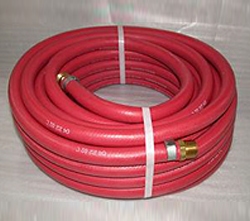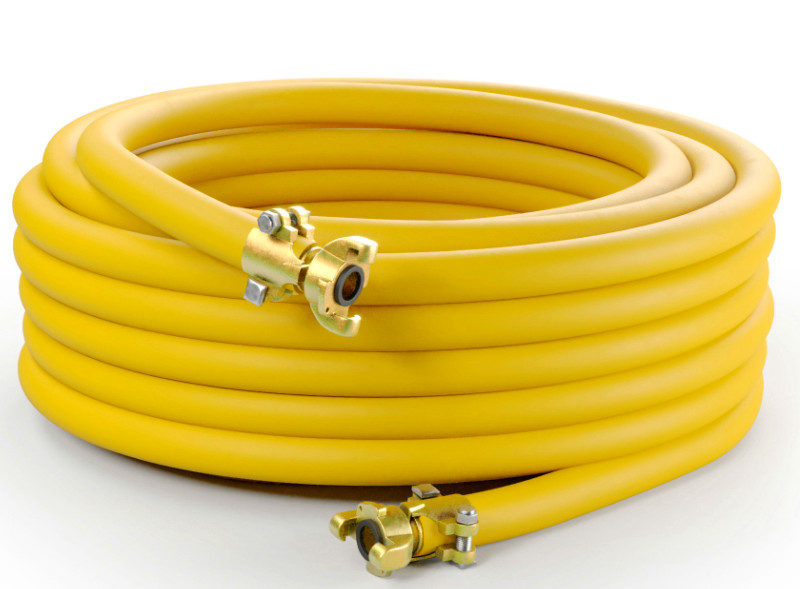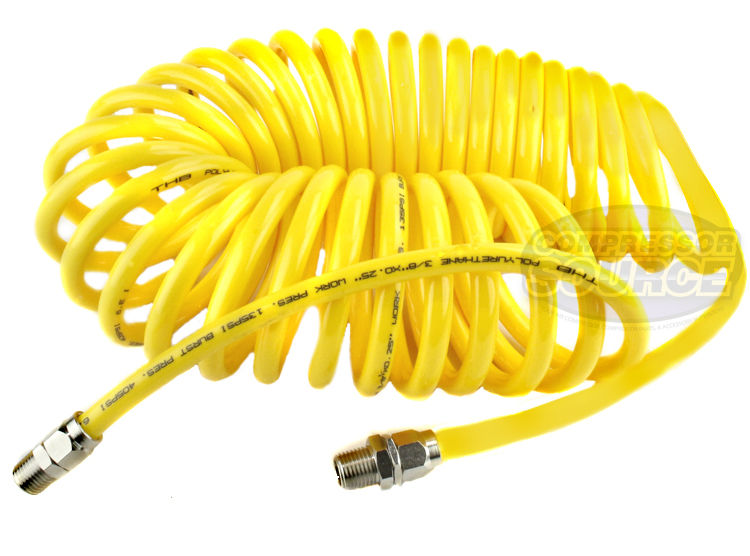A hose for an air compressor is a crucial component that delivers compressed air to tools and equipment. These hoses come in various sizes and materials, designed for specific applications.
Choosing the right hose for your air compressor can significantly impact performance and efficiency. Air compressor hoses typically range in diameter from ¼ inch to ½ inch and come in materials like rubber and polyurethane. Each type offers unique benefits, such as flexibility, durability, and resistance to abrasion.
Ensuring compatibility with your compressor and tools is vital for optimal operation. A high-quality hose enhances safety by reducing risks of leaks or bursts. Understanding the specifications and requirements of your air compressor will help you select the best hose for your needs, ensuring smooth and effective air delivery for all your projects.

Credit: www.compressedairsystems.com
Introduction To Air Compressor Hoses
Air compressor hoses play a crucial role in various applications. They connect the air compressor to tools and equipment. Choosing the right hose ensures efficiency and safety. Understanding hose types and specifications is vital for optimal performance.
Importance Of Choosing The Right Hose
Using the correct air compressor hose affects many factors:
- Performance: A suitable hose enhances airflow and pressure.
- Durability: Quality hoses resist wear and tear.
- Safety: Proper hoses prevent leaks and accidents.
- Efficiency: Right hoses minimize energy loss.
Investing in a good hose saves time and money. Poor choices lead to frequent replacements. Selecting the right hose is essential for any project.
Criteria For Selecting The Best Hose
Consider these criteria for choosing the best air compressor hose:
- Material: Common materials include rubber, PVC, and polyurethane.
- Length: Choose a length that suits your workspace.
- Diameter: A larger diameter allows more airflow.
- Pressure Rating: Ensure it matches your compressor’s output.
- Temperature Rating: Check if the hose can handle extreme conditions.
Here’s a quick comparison of common hose materials:
| Material | Durability | Flexibility | Cost |
|---|---|---|---|
| Rubber | High | Moderate | Medium |
| PVC | Medium | High | Low |
| Polyurethane | High | Very High | High |
Choosing wisely ensures long-lasting performance. Evaluate your needs carefully before buying.
Types Of Air Compressor Hoses
Choosing the right air compressor hose is crucial for performance. Different materials offer unique advantages. Understanding these types helps in making informed decisions.
Rubber Hoses: Pros And Cons
Rubber hoses are popular for their strength and durability. Here are their main advantages:
- Durability: Resistant to wear and tear.
- Flexibility: Easy to maneuver in tight spaces.
- Temperature Resistance: Works well in extreme conditions.
However, rubber hoses have some downsides:
- Weight: Heavier than other options.
- Cost: Generally more expensive.
Pvc Hoses: Lightweight Options
PVC hoses are a lightweight alternative. They are easy to carry and handle. Here are some key features:
- Lightweight: Easy to transport.
- Cost-Effective: Usually cheaper than rubber hoses.
- Resistance: Good against chemicals and abrasion.
Keep in mind the drawbacks:
- Less Flexible: Can kink under pressure.
- Temperature Limitations: Not ideal for extreme heat.
Polyurethane Hoses: Flexibility And Durability
Polyurethane hoses offer an excellent mix of flexibility and strength. They are lightweight and resistant. Here are their key benefits:
- High Flexibility: Easy to bend and maneuver.
- Durability: Resistant to punctures and abrasions.
- Low Temperature Resistance: Works in colder climates.
However, there are some disadvantages:
- Cost: More expensive than PVC.
- Limited Heat Resistance: Not suitable for high temperatures.
Key Features To Consider
Choosing the right hose for your air compressor is essential. Focus on these key features. They affect performance and durability. Understand each feature to make an informed choice.
Length And Diameter
The hose’s length and diameter impact air delivery. Here are some points to consider:
- Length: Longer hoses reduce airflow. Choose a length suitable for your needs.
- Diameter: Larger diameters allow more airflow. Common sizes are 1/4″, 3/8″, and 1/2″.
Check the specifications of your air compressor. Match the hose length and diameter for optimal performance.
Pressure Ratings And Compatibility
Pressure ratings determine how much pressure the hose can handle. Consider the following:
| Pressure Rating | Common Use |
|---|---|
| 150 PSI | General air tools |
| 300 PSI | Heavy-duty applications |
| 500 PSI | Industrial use |
Ensure the hose is compatible with your air compressor. Mismatched ratings can cause damage.
Connectors And Fittings
Connectors and fittings affect how the hose connects to tools. Pay attention to these factors:
- Types: Common types include quick-connect, threaded, and barbed.
- Material: Choose durable materials like brass or aluminum.
- Size: Match the connector size to your air tools.
Proper fittings ensure a secure connection. This prevents air leaks and improves efficiency.
Top Hose Picks For Indoor Use
Choosing the right hose for your air compressor is essential. An effective hose enhances performance for various indoor tasks. Here are the best options tailored for different needs.
Best For Diy Projects
For DIY enthusiasts, flexibility and durability are key. Here are top picks:
- Flexzilla Air Hose
- Durable and lightweight.
- Resistant to kinks.
- Available in various lengths.
- Goodyear Rubber Air Hose
- Strong rubber construction.
- Works well in different temperatures.
- Great for home projects.
Top Choice For Professional Settings
Professionals need hoses that withstand heavy use. Consider these options:
| Hose Name | Features | Ideal Use |
|---|---|---|
| Flexzilla Zilla Green Air Hose | Lightweight, flexible, and crush-resistant. | Industrial applications. |
| Everblades Air Hose | High durability, kink-resistant. | Heavy-duty tasks. |
Select the right hose for your indoor needs. Each option offers unique benefits. Choose wisely for optimal performance.
Top Hose Picks For Outdoor Use
Choosing the right hose for your air compressor is crucial. Outdoor conditions can be tough. A good hose must handle these challenges effectively.
Durability In Harsh Conditions
Outdoor hoses need to be strong and resilient. They face extreme temperatures, UV rays, and abrasions. Here are key features to consider:
- Material: Look for rubber or reinforced PVC.
- Temperature Rating: Ensure it can handle extreme heat and cold.
- UV Resistance: Protects against sun damage.
- Abrasion Resistance: Prevents wear and tear.
These features ensure the hose lasts longer. Investing in quality pays off in the long run.
Preferred Hoses For Construction Sites
Construction sites require reliable hoses that can withstand heavy use. Here are some popular options:
| Hose Type | Length | Material | Pressure Rating |
|---|---|---|---|
| Rubber Air Hose | 50 ft | Rubber | 300 PSI |
| PVC Air Hose | 100 ft | PVC | 250 PSI |
| Reinforced Air Hose | 75 ft | Reinforced PVC | 400 PSI |
Consider these options for your construction site needs:
- Rubber Air Hose: Excellent flexibility and durability.
- PVC Air Hose: Lightweight and easy to handle.
- Reinforced Air Hose: Offers the highest pressure rating.
Selecting the right hose enhances efficiency and safety. Make the best choice for your outdoor projects.

Credit: www.somaxflex.com
Innovative Hose Technologies
New technologies are transforming hoses for air compressors. These innovations improve performance, durability, and ease of use. Users enjoy enhanced functionality and convenience.
Anti-kink Designs
Anti-kink designs prevent hoses from bending and tangling. This feature ensures smooth airflow and reduces pressure loss.
- Flexible materials enhance maneuverability.
- Special reinforcements maintain shape under pressure.
- Less time spent untangling hoses means more efficiency.
Anti-kink hoses are perfect for busy work environments. They allow for quick connections and disconnections, saving time.
Self-retracting Mechanisms
Self-retracting mechanisms offer easy storage solutions. Hoses retract automatically after use, keeping workspaces tidy.
| Feature | Benefit |
|---|---|
| Automatic retraction | Eliminates manual coiling and uncoiling |
| Space-saving design | Maximizes storage areas |
| Durable construction | Resists wear and tear over time |
Self-retracting hoses are ideal for professionals. They provide a clean and organized workspace, improving safety.
Maintenance And Care
Proper maintenance and care for your air compressor hose ensure longevity and optimal performance. Regular checks help prevent leaks and damages. Following simple guidelines keeps your hose in great shape.
Regular Inspection Tips
- Check for cracks or splits in the hose.
- Inspect connections for rust or corrosion.
- Look for kinks that may restrict airflow.
- Ensure fittings are secure and not leaking.
- Examine the entire length for wear and tear.
Inspect your hose before each use. Replace any damaged parts immediately. Regular inspections prevent unexpected breakdowns.
Cleaning And Storage Best Practices
Cleaning your air compressor hose is essential for maintaining airflow. Follow these steps for effective cleaning:
- Disconnect the hose from the compressor.
- Use a damp cloth to wipe the exterior.
- For stubborn dirt, use mild soap and water.
- Rinse thoroughly and let it dry completely.
Proper storage protects your hose from damage. Use these storage tips:
- Store in a cool, dry place.
- Avoid sharp bends when coiling.
- Use a hose reel for organized storage.
- Keep away from direct sunlight.
Following these cleaning and storage practices extends the life of your hose.
Safety Considerations
Using an air compressor requires attention to safety. Proper handling of the hose is vital. Understanding potential hazards can prevent injuries. Follow these guidelines for a safer experience.
Avoiding Common Hazards
Several hazards can arise from improper use of air compressor hoses. Below are common risks:
- Hose damage: Look for cracks or wear.
- High pressure: Avoid exceeding the hose’s limit.
- Trip hazards: Keep hoses clear of walkways.
- Loose connections: Ensure all fittings are secure.
Regularly inspect your hose. This prevents unexpected accidents. Always replace damaged hoses immediately.
Proper Usage To Prevent Accidents
Using the air compressor hose correctly can prevent many accidents. Follow these tips for safe operation:
- Read the manual: Understand specific requirements.
- Wear safety gear: Use goggles and gloves.
- Check pressure settings: Keep them within recommended levels.
- Store hoses properly: Avoid exposure to heat or sharp objects.
- Disconnect when not in use: Prevent accidental activation.
By following these practices, you enhance safety. Always prioritize safe handling of your air compressor hose.

Credit: compressor-source.com
Frequently Asked Questions
What Size Hose For An Air Compressor?
The size of the hose for an air compressor typically ranges from 1/4 inch to 1/2 inch in diameter. A 1/4 inch hose is suitable for light tasks, while a 3/8 inch or 1/2 inch hose is better for heavier applications.
Choose based on your compressor’s output and intended use.
How Long Can An Air Compressor Hose Be?
An air compressor hose can be up to 100 feet long. However, longer hoses may reduce airflow and pressure. For optimal performance, keep the hose length as short as necessary. Consider the trade-off between reach and efficiency when selecting hose length.
What Type Of Hose Is Best For Air Compressors?
The best type of hose for air compressors is typically polyurethane or rubber. These materials are durable, flexible, and resistant to abrasion. A lightweight hose improves maneuverability and reduces fatigue. Always check compatibility with your specific compressor model before purchasing.
Can You Use A Garden Hose For Air Compressor?
Using a garden hose with an air compressor is not recommended. Garden hoses cannot handle high-pressure air and may burst. Instead, use a dedicated air hose designed for high-pressure applications. This ensures safety and optimal performance during use.
Conclusion
Choosing the right hose for your air compressor is essential for optimal performance. Consider factors like material, length, and pressure rating. A quality hose enhances efficiency and durability. Invest wisely to ensure your projects run smoothly. With the right hose, you’ll achieve the best results for all your air compressor needs.

